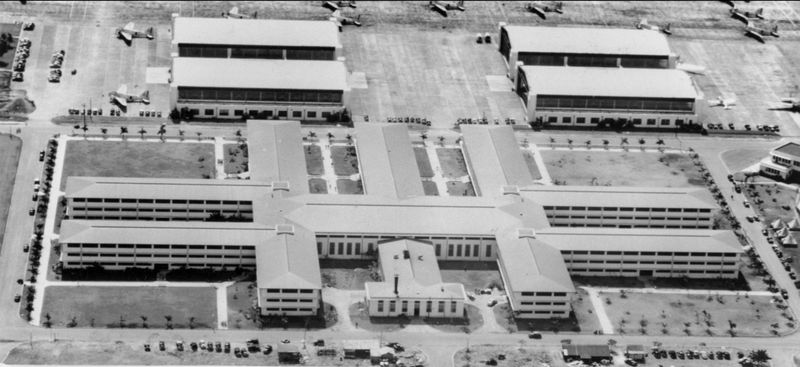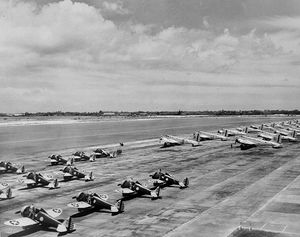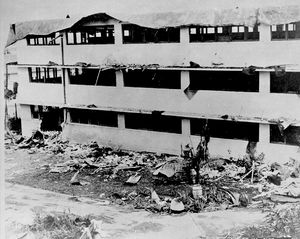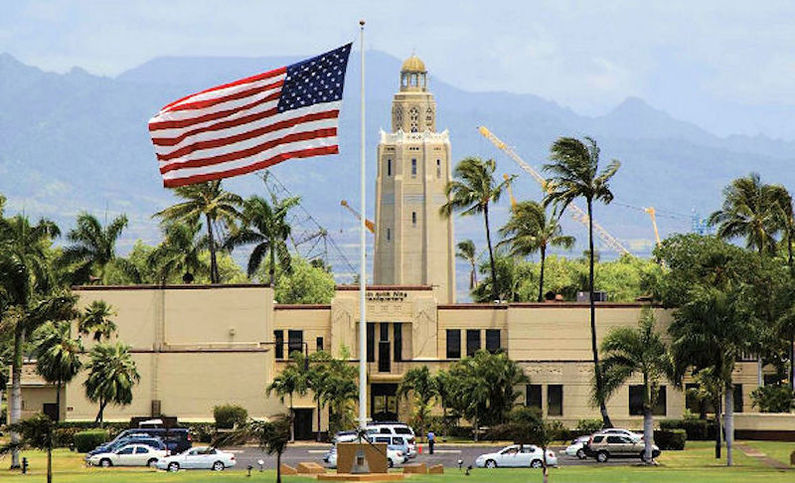Hickam Air Force Base
|
Pre World War II(Text adapted from USAF Fact Sheet)
Among the historic buildings constructed and still standing on Hickam Field is Bldg 1102, built as a 3200 man barracks, now serving as HQ Pacific Air Forces. Construction on the three-story, multi-winged facility began in 1939 and was completed in 1940. At the center of the building was a 26,741 square foot dining hall that seated and fed 2,000 men. Other buildings still standing include the Officers's Club, the base operations building and numerous NCO and Officer quarters. 
 Aircraft were brought to Hawaii throughout 1941 to prepare for potential hostilities. The first mass flight of twenty-one B-17D bombers from Hamilton Field, California, arrived at Hickam Field on 14 May 1941. By December 1941, the Hawaiian Air Force had been an integrated command for slightly more than one year and consisted of 754 officers and 6,706 enlisted men, with 233 aircraft assigned at its three primary bases on Oahu (Hickam Field, Wheeler Field and Bellows Field).
World War II (1941-1945) The Japanese attacked Oahu's military installations on 7 Dec 1941, Hickam suffered extensive damage, aircraft losses, and personnel casualties totaling 139 killed and 303 wounded. The Japanese bombed and strafed Hickam Field to eliminating air opposition and to prevent U.S. planes from following their aircraft back to their carriers. About one hundred Japanese bombs were dropped on Hickam Field on 7 Dec 1941. Twenty seven bombs hit Barracks Building 1102 and the blasts killed many soldiers on the top two floors. The mess hall took a direct hit from a five hundred pound bomb during breakfast, instantly killing thirty five men. The tattered American flag that flew over the base that morning is on display in the lobby of the Pacific Air Forces Headquarters building, where bullet-scarred walls have been carefully preserved to remind visitors of that day. During the war years, the base played a major role in pilot training and aircraft assembly work, and as a supply center for both air and ground troops. Hickam served as the hub of the Pacific aerial network, supporting transient aircraft ferrying troops and supplies to, and evacuating wounded from the forward areas.
Cold War (1947–1991)After World War II, the Air Force in Hawaii was primarily comprised of the Air Transport Command and its successor, the Military Air Transport Service. After the creation of the separate United States Air Force Hickam was named Hickam Air Force Base on 26 Mar 1948. On 1 Jul 1957 Headquarters Far East Air Forces completed its move from Japan to Hawaii and was redesignated the Pacific Air Forces at Hickam AFB. During the Korean War and the Vietnam War Hickam continued to served as the hub of the Pacific aerial network, supporting transient aircraft ferrying troops and supplies to, and evacuating wounded from the forward areas. Host units at Hickam Air Force Base, supported the Apollo astronauts in the 1960s and 1970s; Operation Homecoming (return of prisoners of war from Vietnam) in 1973; Operation Baby Lift/New Life (movement of nearly 94,000 orphans, refugees, and evacuees from Southeast Asia) in 1975; and NASA's space shuttle flights during the 1980s, continuing into the 1990s. In October 1980, the Secretary of the Interior designated Hickam AFB as a National Historic Landmark, recognizing it as one of the nation's most significant historic resources associated with World War II in the Pacific.
Current StatusActive military reservation, access may be restricted.
See Also: Sources:
Links: Visited: No
| ||||||||||||||||||||||||
